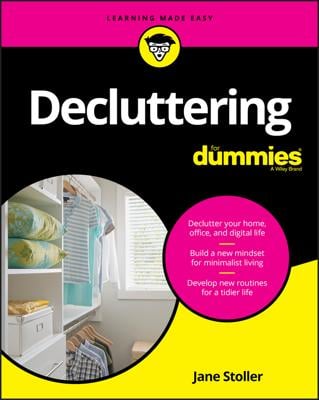After you’ve psyched yourself up for some serious decluttering, try using the following techniques:
-
Pick any number from one to two: When considering what to do with an item of clutter, remember that you have two basic options: Keep it or lose it. If you decide to keep it, you must figure out what to do with it. If you choose to lose it, you can chuck it or give it away. Clearly, the biggest obstacle to getting rid of anything is having to make this choice.
-
Use the Triage Method of Clutter Control: Create three categories: Definitely Keep, Definitely Get Rid Of, and I’m Not Sure. Then throw out or give away everything in the last two categories. The upside of unloading much more of your clutter far outweighs the downside of making a mistake. Don’t look back.
- If it doesn’t work, toss it: Look around your home for a broken toaster, blender, vacuum cleaner, radio, or clock — any small appliance that hasn’t worked for a long while. Once you find one, ask yourself whether you truly need it. If you decide to fix it, fix it. If not, replace or discard it.
Taking a second look
- Reassess your keeper pile: It’s never too late to get rid of some of the stuff that you decide to keep. Go back over your keeper pile and take a second look. Organizing even a small pile of things takes a lot of time. And, although storage and filing plays an important role in managing all the possessions that clutter your life, simply getting rid of stuff often makes more sense.
-
Play the dating game: If you can’t bring yourself to throw something out today, put it in a box and put a date on the box that is exactly a year away. Don’t list what’s in the box — just the date. If you find that future date has come and gone without your needing anything in the box, chuck it, without looking inside. Don’t look back. And should you need and use some of the things from a box, find a good place to keep those items.
Getting others involved
- Get a clutter buddy: You’re probably less sentimental, less ambivalent, and more determined when dealing with other people’s clutter than your own. Make this concept work for you. Ask your mate or a friend to help you de-clutter. Listen to that person, and do what he or she tells you.
-
Find a clutter recipient. Getting rid of stuff is much easier when you know that it won’t end up in the trash, but in the hands of somebody who wants it and can use it. In fact, your rejects may be someone else’s cup of tea.
Clothing, sports equipment, books, and furniture are often welcomed by others. Give your relatives and friends first crack at your treasures. The Salvation Army, Goodwill Industries, thrift shops, and charity drives would all be delighted to take the stuff that your family and friends turn down. You can even get a tax deduction for donating to charitable organizations.
Getting organized
-
Invest in doors and drawers: Store things in cabinets and closets with drawers, in bureau drawers or file cabinets — anyplace that contributes to a sense of visual order. But remember that the space things occupy behind doors is still space that you could use for something else.
-
Take a sample: Create a large art folder and began taking samples of your children’s masterpieces you are especially fond of. Get rid of the rest.
-
Take a picture: Often, items in your “I’m Not Sure” pile have sentimental value or are too big to keep around. You want the memories, but not necessarily the object. Take its picture. Pictures take up far less space and still can bring a warm smile to your face.

